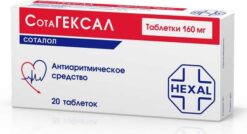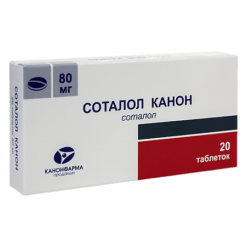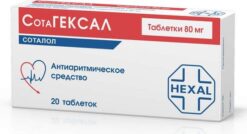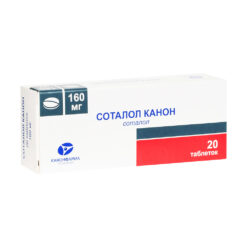No products in the cart.
Sotalol, tablets 160 mg 20 pcs
€4.91 €4.36
Description
Pharmacotherapeutic group: Non-selective beta-adrenoblocker
ATC code: C07AA
Pharmacodynamics:
Sotalol is a class II and III antiarrhythmic agent according to Vaughan-Williams classification with the properties of a non-selective beta-adrenoblocker. It is a racemic mixture consisting of D- and L-stereoisomers of sotalol. Both isomers have class III antiarrhythmic effects while the L-stereoisomer is responsible for virtually all beta-adrenoblocking actions.
Sotalol has no sympathomimetic or membrane-stabilizing activity of its own.
Like other beta-adrenoblockers, sotalol suppresses renin secretion, and this effect is pronounced both at rest and under load.
The beta-adrenoblocking action of sotalol causes a decrease in heart rate (HR) (negative chronotropic effect) and a limited decrease in heart force (negative inotropic effect). These changes in heart rate reduce myocardial oxygen demand and the amount of load on the heart.
The antiarrhythmic properties of sotalol are associated with both the ability to block beta-adrenergic receptors and the ability to prolong myocardial action potential. The main effect of sotalol is to increase the duration of effective refractory periods in the atrial ventricular and accessory pulse conduction pathways.
Pharmacokinetics:
Absorption
Bioavailability with oral administration is 90-100%.
The maximum plasma concentration is reached 25-4 h after oral administration and equilibrium concentration within 2-3 days (i.e. after 5-6 doses when taken 2 times daily).
The absorption of Sotalol is reduced by approximately 20% when combined with food compared to fasting.
In the dose range of 40 to 640 mg/day, the plasma concentration of Sotalol is proportional to the dose taken.
The pharmacokinetics of the D- and L-enantiomers of sotalol are virtually identical.
Distribution
Distribution occurs in plasma as well as in peripheral organs and tissues with a half-life of 10-20 h. Sotalol does not bind to plasma proteins. It poorly penetrates through the blood-brain barrier and its concentration in cerebrospinal fluid is only 10% of that in blood plasma.
Metabolism
Sotalol does not undergo metabolism.
Elevation
The main route of excretion from the body is excretion through the kidneys. About 80% to 90% of the administered dose is excreted unchanged by the kidneys and the rest is excreted through the intestines.
The elimination half-life of Sotalol is 10-20 hours.
Patient special groups
Patients with impaired renal function should use lower doses of the drug.
The pharmacokinetics do not change much with patient age, although impaired renal function in older patients decreases the excretion rate, which leads to increased accumulation of sotalol in the body.
Indications
Indications
Ventricular arrhythmia:
prevention of relapses of life-threatening ventricular tachyarrhythmia;
treatment of symptomatic unsustained ventricular tachyarrhythmia.
Supraventricular arrhythmia:
prevention of the development of paroxysmal atrial tachycardia, paroxysmal atrial fibrillation, paroxysmal atrioventricular nodal reciprocal tachycardia of the “re-entry” type, paroxysmal atrioventricular reciprocal tachycardia with the participation of additional pathways and paroxysmal supraventricular tachycardia after surgery;
maintaining normal sinus rhythm after conversion of atrial fibrillation or atrial flutter.
Pharmacological effect
Pharmacological effect
Pharmacotherapeutic group: Non-selective beta-blocker
ATX code: C07AA
Pharmacodynamics:
Sotalol is an antiarrhythmic drug of class II and III according to the Vaughan-Williams classification with the properties of a non-selective beta-blocker. It is a racemic mixture consisting of D- and L-stereoisomers of sotalol. Both isomers have class III antiarrhythmic effects, while the L-stereoisomer is responsible for almost all beta-blocking effects.
Sotalol does not have its own sympathomimetic and membrane-stabilizing activity.
Like other beta-blockers, sotalol suppresses renin secretion, and this effect is pronounced both at rest and during exercise.
The beta-blocking effect of sotalol causes a decrease in heart rate (HR) (negative chronotropic effect) and a limited decrease in the force of heart contractions (negative inotropic effect). These changes in cardiac activity reduce the myocardial oxygen demand and the amount of workload on the heart.
The antiarrhythmic properties of sotalol are associated both with the ability to block beta-adrenergic receptors and with the ability to prolong the myocardial action potential. The main effect of sotalol is to increase the duration of effective refractory periods in the atrial ventricular and accessory impulse pathways.
Pharmacokinetics:
Absorption
Bioavailability when taken orally is 90-100%.
The maximum concentration in the blood plasma is achieved 25-4 hours after oral administration and the equilibrium concentration is within 2-3 days (i.e. after taking 5-6 doses when taken 2 times a day).
The absorption of sotalol is reduced by approximately 20% when taken with food compared to when taken on an empty stomach.
In the dose range from 40 to 640 mg/day, the concentration of sotalol in the blood plasma is proportional to the dose taken.
The pharmacokinetics of the D- and L-enantiomers of sotalol are almost the same.
Distribution
Distribution occurs in the blood plasma as well as in peripheral organs and tissues, with a half-life of 10-20 hours. Sotalol does not bind to blood plasma proteins. It penetrates the blood-brain barrier poorly and its concentration in the cerebrospinal fluid is only 10% of the concentration in the blood plasma.
Metabolism
Sotalol is not metabolized.
Removal
The main route of elimination from the body is excretion through the kidneys. From 80% to 90% of the administered dose is excreted unchanged by the kidneys and the rest through the intestines.
The half-life of sotalol is 10-20 hours.
Special patient groups
Patients with impaired renal function should use lower doses of the drug.
As the patient ages, the pharmacokinetics change slightly, although impaired renal function in elderly patients reduces the rate of elimination, which leads to increased accumulation of sotalol in the body.
Special instructions
Special instructions
Monitoring the patient’s condition
Treatment with Sotalol is carried out under the control of heart rate, blood pressure, and ECG.
The initiation of Sotalol therapy or a change in dosage should be accompanied by an appropriate medical examination including ECG monitoring with assessment of the QT interval, monitoring of renal function, measurement of electrolytes, as well as concomitant therapy.
The patient should be taught how to calculate heart rate and the patient should be instructed to consult a doctor if the heart rate is less than 60 beats/min.
If elderly patients develop increasing bradycardia (less than 60 beats/min), arterial hypotension (systolic blood pressure less than 100 mmHg), AV blockade, bronchospasm, ventricular arrhythmia, severe liver and kidney dysfunction, it is necessary to reduce the dose of the drug or discontinue therapy.
Withdrawal of the drug
After discontinuation of beta-blockers, patients experience increased sensitivity to catecholamines. After abrupt cessation of therapy, isolated cases of exacerbation of angina, arrhythmia, and in some cases the development of myocardial infarction have been reported. Therefore, if it is necessary to discontinue the drug Sotalol, the dose should be reduced gradually, especially in patients with coronary heart disease after a myocardial infarction with arterial hypertension. Treatment should not be abruptly interrupted due to the risk of developing severe arrhythmias and myocardial infarction.
Careful monitoring of the patient is recommended, especially with coronary heart disease. If possible, the dose should be reduced gradually over one or two weeks. If necessary, it is recommended to prescribe replacement therapy. Abrupt cessation of drug use can provoke “latent” coronary insufficiency and the development of arterial hypertension.
Proarrhythmogenic effect
The most dangerous side effect of antiarrhythmic drugs is the exacerbation of existing arrhythmias or the provocation of new arrhythmias. Drugs that prolong the QT interval can provoke torsade de pointes (TdP). The occurrence of such arrhythmias is associated with prolongation of the QT interval, a decrease in heart rate, a decrease in serum potassium and magnesium levels with high plasma concentrations of sotalol, as well as the simultaneous use of other drugs that prolong the QT interval. In women, these complications occur more often.
Polymorphic ventricular tachycardia of the “pirouette” type usually occurs early after the start of therapy or with an increase in dose and stops spontaneously in most patients. At the same time, dose titration reduces the risk of proarrhythmia. Other risk factors for the occurrence of polymorphic ventricular tachycardia of the “pirouette” type include a significant prolongation of the QT interval in combination with cardiomegaly or chronic heart failure.
Patients with sustained ventricular tachycardia and chronic heart failure have the highest risk of serious arrhythmias (7%).
The drug Sotalol should be used with extreme caution when the QT interval is longer than 480 ms, and the dose of the drug must be reduced. If the duration of the QT interval exceeds 550 ms, therapy should be discontinued.
Sotalol can be used after previously administered antiarrhythmic therapy only under the condition of careful monitoring and after at least 2-3 half-lives of the previously prescribed antiarrhythmic drug (see section “Interaction with other drugs”).
ECG changes
Excessive prolongation of the QT interval (more than 550 ms) may be a sign of drug toxicity.
Electrolyte disturbances
Sotalol should not be used in patients with hypokalemia or hypomagnesemia until the existing disorders are corrected because These conditions can lead to prolongation of the QT interval and increase the likelihood of polymorphic ventricular tachycardia of the “pirouette” type. These electrolyte disturbances must be corrected before starting Sotalol.
Monitoring of water-electrolyte balance and acid-base status is necessary in patients with severe or prolonged diarrhea and in patients receiving medications that cause a decrease in magnesium and/or potassium in the body.
Chronic heart failure (CHF)
Blockade of beta-adrenergic receptors can further reduce myocardial contractility and provoke a worsening of the symptoms of CHF. Caution must be exercised when using the drug Sotalol in patients with CHF receiving standard therapy (angiotensin-converting enzyme inhibitors, diuretics, cardiac glycosides, etc.). In patients with left ventricular dysfunction, a lower initial dose of sotalol should be used at the beginning of therapy and then the dose should be adjusted based on the clinical situation.
Myocardial infarction
A positive ratio of the expected benefit to the possible risk of using sotalol in patients after myocardial infarction with impaired left ventricular function has not been proven. Careful patient monitoring and dose titration are critical during initiation and continuation of therapy. Sotalol should not be used in patients with a left ventricular ejection fraction <40% without serious ventricular arrhythmias.
Anaphylactoid reactions
When beta-blockers are used in patients with a history of anaphylactic reactions to various allergens, more serious allergic reactions may occur upon repeated exposure to the antigen. Such patients may not respond to the usual doses of epinephrine (adrenaline) used to treat an allergic reaction. Therefore, the drug Sotalol should be used with extreme caution if there is a history of allergic reactions, as well as against the background of desensitizing therapy.
Diabetes mellitus
Sotalol should be used with caution in patients with diabetes mellitus or with a history of episodes of spontaneous hypoglycemia, since the use of beta-blockers may mask signs of the onset of acute hypoglycemia (for example, tachycardia).
Thyrotoxicosis
The use of beta-blockers may hide some clinical signs of hyperthyroidism (for example, tachycardia). Abrupt withdrawal in patients with thyretoxicosis is contraindicated because it can increase the symptoms of the disease. Patients with suspected thyrotoxicosis need careful monitoring to avoid the development of thyrotoxicosis, including thyrotoxic crisis, when the drug is discontinued.
Pheochromocytoma
When using sotalol in patients with pheochromocytoma, alpha-blockers should be used simultaneously.
Psoriasis
Beta blockers may worsen psoriasis.
Smoking
In smokers, the effectiveness of beta-blockers is lower than in non-smokers.
Renal dysfunction
Since sotalol is primarily excreted by the kidneys, dose adjustment is required in patients with impaired renal function.
Laboratory research
The drug should be discontinued before determining the catecholamines normetanephrine and vanillylmandelic acid in the blood and urine; antinuclear antibody titers.
Other
Patients using contact lenses should take into account that during therapy with sotalol, a decrease in the production of tear fluid is possible.
It is recommended to discontinue therapy if depression develops due to beta-blockers.
Like other beta-blockers, Sotalol should be used with caution in patients undergoing surgery.
During therapy it is necessary to avoid alcohol intake.
Sotalol should be used with caution in elderly patients.
Impact on the ability to drive vehicles. Wed and fur.:
Care must be taken when driving vehicles and engaging in other potentially hazardous activities that require increased concentration and speed of psychomotor reactions (risk of developing headaches and increased fatigue).
Active ingredient
Active ingredient
Sotalol
Composition
Composition
Composition per 160 mg tablet:
Active ingredient:
sotalol hydrochloride – 160.00 mg.
Excipients:
lactose monohydrate (milk sugar) – 157.30 mg,
corn starch – 30.40 mg,
sodium carboxymethyl starch – 15.20 mg,
povidone-K25 – 1 1.40 mg,
magnesium stearate – 3.80 mg,
colloidal silicon dioxide – 1.90 mg.
Pregnancy
Pregnancy
Pregnancy
There have been no adequate controlled studies in pregnant women. In animal studies, sotalol did not cause teratogenic or other damaging effects on the fetus.
The use of the drug Sotalol during pregnancy, especially in the first trimester, is possible only for health reasons when the benefit of use for the mother outweighs the possible risk of developing adverse effects in the fetus/child.
Sotalol crosses the placenta and is found in amniotic fluid. Beta-blockers reduce placental blood flow, which can lead to intrauterine fetal death, premature birth, and the birth of an immature fetus. In addition, adverse events (in particular hypoglycemia and bradycardia) may occur in the fetus and newborn. If therapy is administered during pregnancy, the drug should be discontinued 48-72 hours before the expected due date due to the possibility of developing bradycardia, arterial hypotension, hypokalemia and respiratory depression in newborns. There is an increased risk of heart and lung complications in newborns during the postpartum period. Careful monitoring of the condition of newborns is necessary for 48-72 hours after birth.
Breastfeeding period
Sotalol passes into breast milk and reaches effective concentrations there. If it is necessary to use the drug during lactation, breastfeeding should be stopped.
Contraindications
Contraindications
– Hypersensitivity to sotalol, other components of the drug and to other sulfonamide derivatives;
– signs of sick sinus syndrome including sinoauricular (sinoatrial) block, except in the presence of a functioning artificial heart pacemaker;
– atrioventricular (AV) block of II or III degree;
– congenital or acquired long QT syndrome or the use of drugs that can prolong the QT interval (see section “Interaction with other drugs”);
– bidirectional fusiform ventricular tachycardia (polymorphic ventricular tachycardia of the “pirouette” type) or the use of drugs associated with this disorder (see section “Interaction with other drugs”);
– symptomatic sinus bradycardia (heart rate less than 50 beats/min);
– uncontrolled chronic heart failure (CHF), including right ventricular CHF due to pulmonary hypertension;
– cardiogenic shock;
– general anesthesia causing suppression of myocardial function;
– arterial hypotension (systolic blood pressure (BP) less than 90 mm Hg) except in cases caused by arrhythmia;
– severe peripheral circulatory disorders including Raynaud’s syndrome;
– history of bronchial asthma or chronic obstructive pulmonary disease (COPD);
– metabolic acidosis;
– renal failure (creatinine clearance < 10 ml/min);
– pheochromocytoma (without simultaneous use of alpha-blockers);
– breastfeeding period;
– age under 18 years (efficacy and safety have not been established);
– lactose intolerance, lactase deficiency and glucose-galactose malabsorption syndrome.
With caution:
Caution should be exercised when using the drug Sotalol in patients who have recently suffered a myocardial infarction (not earlier than 2 weeks after the myocardial infarction), diabetes mellitus, psoriasis, impaired renal function (creatinine clearance more than 10 ml/min), atrioventricular (AV) block of the first degree of chronic heart failure with disturbances of water and electrolyte balance: hypomagnesemia, hypokalemia; with prolongation of the QT interval in old age during surgical interventions, a history of allergic reactions (possibly increased sensitivity to allergens, worsening of arterial hypertension and a decrease in the therapeutic response to adrenaline) as well as against the background of desensitizing therapy for obliterating diseases of peripheral vessels, bronchospasm (history).
Side Effects
Side Effects
According to the World Health Organization, undesirable effects are classified according to their frequency of development as follows: often (> 1/100 1/1000 1/10000 < 1/1000) and very rarely (< 1/10000) including individual reports; frequency unknown - based on available data, it was not possible to determine the frequency of occurrence.
Mental disorders: often – anxiety, sleep disturbance (drowsiness or insomnia), mood changes, depression, a state of depression.
Nervous system disorders: often – headache, dizziness, light hallucinations, asthenia, paresthesia in the extremities, syncope; frequency unknown – tremor.
Violations of the organ of vision: often – visual disturbances; very rarely – decreased tear production; frequency unknown – inflammation of the cornea and conjunctiva (should be taken into account when wearing contact lenses).
Hearing disorders and labyrinthine disorders: often – hearing impairment.
Cardiac disorders: often – bradycardia, palpitations, heart rhythm disturbances, shortness of breath, chest pain, AV block, increased symptoms of heart failure, proarrhythmia, polymorphic ventricular tachycardia of the “pirouette” type; frequency unknown – increased angina attacks.
Vascular disorders: often – decreased blood pressure, peripheral edema; frequency unknown – fainting, cold extremities, Raynaud’s disease, short-term exacerbation of intermittent claudication.
Disorders of the respiratory system of the chest and mediastinum: infrequently – bronchospasm (especially if pulmonary ventilation is impaired).
Gastrointestinal disorders: often – changes in taste, dyspepsia (nausea, vomiting), diarrhea, constipation, dry oral mucosa, abdominal pain, flatulence.
Disorders of the skin and subcutaneous tissues: frequency unknown – skin rash, itching, redness of the skin, psoriasiform dermatosis, alopecia, urticaria.
Musculoskeletal and connective tissue disorders: often – muscle weakness, cramps.
Disorders of the genital organs and mammary gland: often – decreased potency.
General disorders and disorders at the injection site: often – increased fatigue, asthenia, fever.
Laboratory and instrumental data: frequency unknown – an increase in the titer of antinuclear antibodies; inflated results may be observed in a photometric analysis of urine for metanephrine (O-methyladrenaline).
Metabolic and nutritional disorders: frequency unknown – hypoglycemia (most likely in patients with diabetes mellitus or on strict diet).
Interaction
Interaction
Antiarrhythmic drugs
Concomitant use of sotalol with class IA (disopyramide quinidine procainamide) and class III antiarrhythmic drugs (eg amiodarone dronedarone) may cause QT prolongation.
Digoxin
The use of sotalol does not have a significant effect on the concentration of digoxin in the blood serum. Arrhythmogenic effects developed more often in patients taking sotalol and digoxin simultaneously; however, this may be due to chronic heart failure, which is a risk factor for arrhythmogenic effects in patients receiving digoxin.
Blockers of “slow” calcium channels (SCBC)
The simultaneous administration of beta-blockers and BMCC can lead to arterial hypotension, bradycardia, conduction disturbances and heart failure.
The simultaneous use of beta-blockers with BMCCs that suppress myocardial function (for example, verapamil and diltiazem) should be avoided due to the additive effect of these drugs on AV conduction and ventricular function. Intravenous administration of these drugs should be avoided while using sotalol (except in emergency situations).
Potassium-sparing diuretics (eg furosemide hydrochlorothiazide)
The use of diuretics of this type can lead to hypokalemia or hypomagnesemia, which increases the likelihood of polymorphic ventricular tachycardia of the “pirouette” type.
Drugs that prolong the QT interval
Sotalol should be used with extreme caution simultaneously with drugs that prolong the QT interval, such as class I antiarrhythmic drugs, phenothiazine derivatives, tricyclic antidepressants, H1-antihistamines (terfenadine and astemizole), as well as some quinolone antibiotics.
Drugs that reduce the concentration of catecholamines
The simultaneous use of drugs that deplete catecholamine stores (for example, reserpine and guanethidine) with beta-blockers leads to excessive suppression of the tone of the sympathetic nervous system at rest.
Patients should be carefully monitored due to possible signs of a marked decrease in blood pressure and/or severe bradycardia, which can lead to syncope.
Insulin or oral hypoglycemic agents
Hyperglycemia may develop; in this case, dose adjustment of hypoglycemic agents is necessary. Sotalol may mask the symptoms of hypoglycemia.
Beta2-agonists
When used concomitantly with sotalol, higher doses of beta2-agonists such as salbutamol, terbutaline and isoprenaline may be required.
Norepinephrine and MAO inhibitors
Concomitant use of norepinephrine (norepinephrine) or MAO inhibitors may cause hypertension.
Clonidine
Beta blockers may potentiate withdrawal hypertension following discontinuation of clonidine. Therefore, beta blockers should be discontinued gradually several days before stopping clonidine. Clonidine should also be withdrawn gradually and only a few days after stopping use of sotalol.
Floctafenine
In case of shock or arterial hypotension caused by floctafenine, β-blockers cause a decrease in compensatory cardiovascular reactions.
Tricyclic antidepressants barbiturates phenothiazine derivatives narcotic and antihypertensive drugs diuretics and vasodilators
When used simultaneously with sotalol, they can cause a sharp decrease in blood pressure.
Tubocurarine
The use of inhalation anesthesia agents, including tubocurarine, while taking sotalol increases the risk of suppression of myocardial function and the development of arterial hypotension.
Isoenzymes of the cytochrome P450 system
Sotalol is not expected to interact with drugs that are metabolized by isoenzymes of the cytochrome P450 system.
Amphotericin B gluco- and mineralocorticosteroids (for systemic use) some laxatives
Hypokalemia may occur. Monitoring of potassium levels is necessary when used concomitantly with sotalol.
Overdose
Overdose
Symptoms: decreased blood pressure bradycardia bronchospasm hypoglycemia loss of consciousness generalized convulsive seizures prolongation of the QT interval ventricular tachycardia (including polymorphic ventricular tachycardia of the “pirouette” type); in severe cases – symptoms of cardiogenic shock – asystole, sometimes with a fatal outcome.
Treatment: gastric lavage, hemodialysis, use of activated carbon.
Symptomatic therapy:
Bradycardia: atropine – 1-2 times intravenously; glucagon – first in the form of a short intravenous infusion at a dose of 02 mg/kg body weight, then at a dose of 05 mg/kg body weight intravenously infused over 12 hours.
Atrioventricular block II-III degree: it is possible to install a temporary artificial pacemaker.
Marked decrease in blood pressure: epinephrine (adrenaline) is effective.
Bronchospasm: aminophylline or beta2-adrenergic receptor sympathomimetics (inhalation).
Polymorphic ventricular tachycardia of the “pirouette” type: cardioversion placement of a temporary artificial pacemaker (if necessary) epinephrine (adrenaline) and/or magnesium sulfate.
Storage conditions
Storage conditions
At a temperature not exceeding 25 °C.
Keep out of the reach of children.
Shelf life
Shelf life
3 years.
Do not use after expiration date.
Manufacturer
Manufacturer
Ozon, Russia
Additional information
| Shelf life | 3 years. Do not use after the expiration date. |
|---|---|
| Conditions of storage | At a temperature not exceeding 25 ° C. Store out of the reach of children. |
| Manufacturer | Ozon, Russia |
| Medication form | pills |
| Brand | Ozon |
Other forms…
Related products
Buy Sotalol, tablets 160 mg 20 pcs with delivery to USA, UK, Europe and over 120 other countries.


















